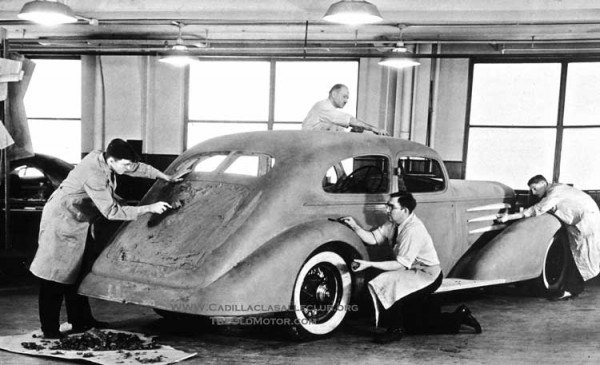GM's First Concept Car and the Influential Result: 1936 Cadillac V16 Aerodynamic Coupe by Fleetwood

This car at first may look to you a lot like any other 1930s coupe, but it was one of the most influential cars of the era, impacting both the way that cars were styled and promoted. You see, in addition to setting the pattern for the way that General Motors’ cars (and their competitors’ cars as well) looked in the immediate prewar period, the 1936 Cadillac Aerodynamic Coupe was GM’s first production car that was based on what we now call a concept car. Back then, though, they were more likely to call those concepts “show cars”, and not only was the Aerodynamic Coupe GM’s first production car derived from a show car, that show car was the giant automaker’s first attempt at creating a one-off vehicle just for promotional purposes. It also represented the solidification of Harley Earl and his styling team’s important role in General Motors’ hierarchy and not so incidentally it helped Cadillac replace Packard as America’s preeminent luxury automaker.
The fact that there was an economic depression going on didn’t stop American car companies from participating in the 1933 Century of Progress world’s fair exposition in Chicago. Ford’s pavilion featured a chandelier made of three full-size Ford cars suspended from the ceiling. Studebaker constructed a mammoth, 80 foot long wooden model of their Land Cruiser automobile. Chevrolet built and operated an actual assembly plant on the fair grounds where you could watch cars being assembled and even take delivery of a new Chevy at the fair.
A number of automakers prepared special cars for the exposition, particularly the luxury marques. Packard created the “Car of the Dome”, sometimes called “the most famous Packard”, a modified Dietrich style sedan. Pierce Arrow showed their radically styled Siver Arrow. Ford displayed an aerodynamic rear-engined prototype designed by John Tjaarda of the Briggs company called the Briggs Dream Car that was the original concept behind the 1936 Lincoln Zephyr, and Duesenberg created a Rollston bodied supercharged Model SJ Arlington Torpedo sedan designed by Gordon Buehrig and nicknamed “Twenty Grand”. That car’s named derived from it’s $20,000 price, the equivalent of over $350,000 today.
Clay modelers working on the Cadillac Aerodynamic Coupe show car for the 1933 Century of Progress world’s fair in Chicago.
With that kind of competition, GM’s newly formed Art and Colour Section took their task seriously. Previewing the fastback rooflines of the 1940s the Cadillac coupe show car had a very long 154 inch wheelbase and a sloping tail. The long and smooth lines were supposed to convey the impression of power and speed. Those lines were accentuated by the sloping rear end and by tapered horizontal accents on the sides of the hood and fenders. Unlike most cars of the day that carried exposed spare tires mounted either on the back of the car or as “side mounts” where the front fenders flowed into the running boards, the Aerodynamic Coupe stashed the spare in the trunk. Actually, that “trunk” inside the bodywork was rather advanced in an era when many luxury cars still had steamer trunks on a rack behind the car to store luggage. Even the exhaust pipes were styled, an innovation that lasts till today, and the exhaust system was tuned to give the car’s V16 engine an appropriate tone.
That V16 engine, in production since 1930 and the first production V16 used for a passenger car, was possibly the first car engine that was styled for aesthetic reasons. The motor received finishes in enamel paint, porcelain, polished aluminum and chrome. Valve covers were polished and detailed. Wiring was hidden away and special attention was paid to how and where the accessories were mounted. The V16 looked so good that Cadillac would apply the same styling to its V8 and V12 engines.
Cadillac Aerodynamic Coupe show car
A “winged goddess” Cadillac hood ornament topped things off and even that received special attention, with a polished finish on its front, while surfaces visible to the driver were dulled, so as not to create glare. Per the coachbuilding terms of the day, the interior was done in”plain style”, about as plain as British “public schools” are public. A dark dashboard is brightened with two slanted strips of chrome, continuing the V motifs that abound on the car. Windows had walnut trim and the various knobs and handles were plated in a satin gold finish. The sun visors were shaped like abstract leaves, made of fine cloth and mounted with screws that had heads of imitation pearl. Instead of metal handles, the doors were closed with rope pulls mounted below the armrests. As would be expected, the deeply cushioned and broad seats were very comfortable.
While the V16 engine didn’t survive past 1940, features of the Aerodynamic Coupe would find their way into production cars for decades, including the all-steel “turret top” roof, a recessed and lighted license plate housing, the fuel filler hidden in the taillight housing (a feature perhaps most famous for its use in the iconic 1957 Chevrolet sedan) and the use of chrome window surrounds and beltline trim to accentuate the coupe’s lines. The Aerodynamic Coupe itself would make it to production in 1936 more or less unchanged from the concept car.
In the following video, Steve Pasteiner, who runs the AAT prototype shop and who was a long time designer at GM, discusses Harley Earl and the influence of the Cadillac Aerodynamic Coupe. I apologize for the video’s audio quality, for some reason it recorded at a low level and I had to boost the gain in editing, resulting in some distortion. It’s still a worthwhile listen for Pasteiner’s insider’s look.
The resulting product was an automobile that looked much more modern to 1930s consumers when compared to the conventional automobiles of the day. Remember, automotive styling was in its infancy in those days and many manufacturers in the 1920s and even later paid virtually no attention to making their cars distinctive. Retired GM designer Dave Holls explained what set the Aerodynamic Coupe apart from its contemporaries, helping to position Cadillac at the top of the American luxury car market:
“Cadillacs were much later than 1933 in form. . . . It was fine styling — if you hold your hand over the front end and look at the car from there back, you begin to see a fair resemblance to the Cord Beverly. . . . This was a time when Cadillac began to make bold, yet careful steps toward change, while Packard hung tenaciously onto its long heritage, making only limited changes. A lot of people went along with them at the time, but the practice established a position, and they were stuck with it, later on with disastrous results.”
This particular 1936 Cadillac Aerodynamic Coupe was not just on display at the 2014 Eyes On Design show, it was featured on the poster for this year’s event. It’s owned by Bill and Barbara Parfet, who are well known among classic car collectors. Mr. Parfet has been president of the foundation that supports the great Gilmore Car Museum in Hickory Corners, Michigan, a bit north of Kalamazoo. The ’36 is one of just 52 V16 Cadillacs made for the 1936 model year, each of them pretty much hand built by Cadillac’s Fleetwood body division. While that number of cars may not seem very significant, that year was the first time Cadillac surpassed Packard in annual sales to become the best-selling U.S. luxury marque, a position it still holds, though its leadership in the overall U.S. luxury segment has, in modern times, been eclipsed by foreign competitors, particularly brands from Germany.
Ronnie Schreiber edits Cars In Depth, a realistic perspective on cars & car culture and the original 3D car site. If you found this post worthwhile, you can get a parallax view at Cars In Depth. If the 3D thing freaks you out, don’t worry, all the photo and video players in use at the site have mono options. Thanks for reading – RJS

Ronnie Schreiber edits Cars In Depth, the original 3D car site.
More by Ronnie Schreiber
Latest Car Reviews
Read moreLatest Product Reviews
Read moreRecent Comments
- Dale Quelle surprise.
- 3SpeedAutomatic Nice looking, but IIRC, there was an issue with these engines where a knock would develop. That may account for the very low milage. 🚗🚗🚗
- Redapple2 Used to watch F 1 a great deal. Now? F1 Random thoughts:1 Silly rules bug me. Must use 2 types of tire. Cant refuel. Drag reduction can only be used in certain areas of the track and only if you are so close to the car in front.2 Passing is rare. Pole sitter wins a high % of the time.3 A new team can only start in F1 if they get the blessing of the overlords. Evil gm Vampire was barred. How about this. Anybody with a car that meets the construction rules can try. If your speed qualifies and you pay the entry fee. You re in. So is anybody else. 4 I tune in for Martin Brundle's grid walk. In my life, it s must see tv. But he is often bumped or cancelled. Grid walk takes place 1 out of 3 or 4 races.5 So, because of this utter bull sheet and other points, I ve migrated to IMSA and MotoGP. I might catch a summary on the youtube.
- Redapple2 I retract my comments and apologize.
- Flashindapan I always thought these look nice. I was working at a Land Rover dealership at the time the LR3 came out and we were all impressed how much better it was then the Discovery in just about every measurable way.










































Comments
Join the conversation
Dumb question here: In cars of the 30s and 40s, they have, as depicted above, a split, 2-piece windshield. Is this just styling, or did the technology not exist to make a one piece windshield?
I love this old Cadillac, truly a stunning effort. As for the suggestion that Cadillac should create a modern equivalnet of this - a no-holds-barred uber-luxury car to trump all others...I say, no chance. If they tried, it would just be an expensive flop. The truth is, that it is harder to get back an image of "standard of the world" when you have lost it, than it is for a company like Hyundai to haul themsleves up. I love and respect OLD Cadillacs for what they once represented but let's be realistic, that boat has long since sailed. Outside of a very limited enclave in SE Michigan, Cadillac do not represent any sort of aspiration any more. I live in SC and generally the only people you see driving Cadillacs are old folks.Few people in the young upwardly-mobile demographic woudl be seen dea in one. The sad thing is that Cadillac (or GM at least, as you could argue that many of the ills were forced upon the Cadillac division by the mothership) were largely responsible for the trashing thier own image. Yes, there were outside factors beyond their control, like the rise of the import luxury brands, or the fuel crises..... but the dilution of the long held brand equity through engineering mediocrity (diesels, 2-4-6-8, Northstar, diminished build quality etc) and disasters like the Cimmaron, were all of their own making. You can't get it back. It would probably be easier to start up a completely new brand and persude consumers (over a period of time) that it was luxury premium product - than it is to get consumers to accept that a once-premium brand that has fallen so low as Cadillac can ever be elevated again? As another poster said above- you have to go back a very long way to when Cadillac could credibly lay claim to the "standard of the world" title. Like I said, I have a strong affection of old classic Cadillacs but I think for the fans of the classic cars the desirable ones were pretty much finished by the end of the 1960s?